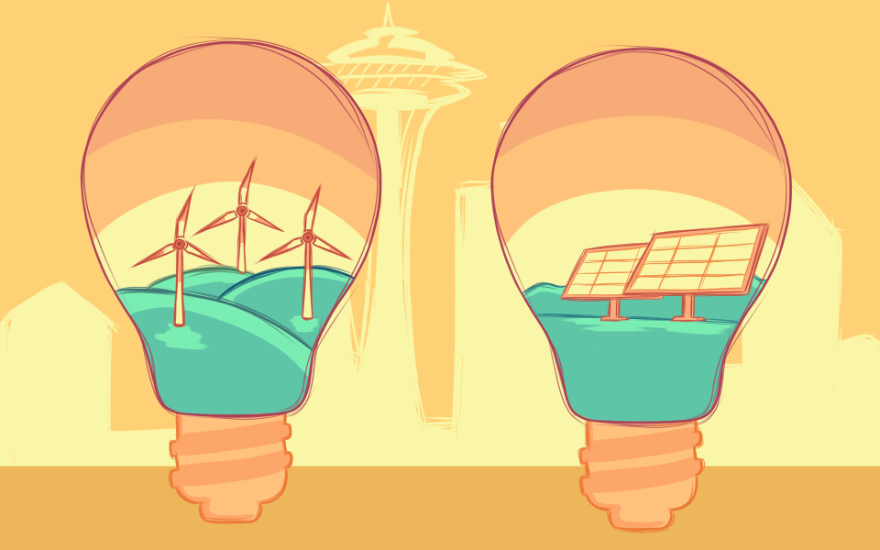
Energy and Buildings

Energy
-
Energy Conservation
-
There is no cheaper, cleaner power than energy you don’t have to produce. That’s why energy conservation is an important strategy to reduce SU's greenhouse gas emissions. Examples of energy conservation projects at Seattle University since 2009:
- SU's resource management plan.
- Personal Appliance Use policy to promote energy efficiency: SU's resource conservation program emphasizes reducing energy consumption and improving efficiency towards the goals defined in the university's Climate Action Plan. The University creates communal lounges/kitchen areas with appropriate appliances (refrigerators, microwaves, sinks) to support the needs of our community in an energy efficient manner. Use of personal appliances for other than the communal spaces is discouraged and must be reviewed and approved by Facilities Operations prior to being placed in service. Personal appliances, such as refrigerators, space heaters, air conditioners, coffee pots, microwaves, etc., add stress to electrical circuits, lead to inefficient energy consumption, and can create a fire hazard. SU members can find the policy on PolicyStats here.
- An innovative heat recovery project (2010) captures waste heat from the pool area exhaust and preheats incoming fresh air and swimming pool water. By "recycling" this waste heat, the system cuts annual CO2 emissions by 1.8 million pounds and reduces our annual energy bill by $82,000.
- In 2011, a new gas boiler was installed to replace the purchase of steam. The boiler heats water and sends it into an underground loop that, in turn, heats the air and water in five buildings. This system has reduced SU's buildings' carbon output and saves $138,000 on the annual energy bill.
- Building mechanical systems are connected to an energy management system which efficiently controls building temperature and ventilation based on each building's occupancy hours.
- Existing light fixtures are being converted to LED lamps as the technology improves and meets a room's needs.
-
Solar Power
-
 The Advancement & Alumni building's rooftop solar panels generate 3% of the building's electrical needs.
The Advancement & Alumni building's rooftop solar panels generate 3% of the building's electrical needs.The Student Center has solar panels mounted on a pole, the south wall and roof. Mechanical Engineering seniors designed the system, Facilities installed it and Seattle City Light funded this 5,500 kWh demonstration project.
The Jim & Janet Sinegal Center for Science and Innovation features a rooftop solar array in its southwest corner and is solar ready in other areas.
-
Carbon Neutral Electricity
-
Our Emissions from electricity are zero because Seattle City Light is 100% carbon neutral. In 2005, Seattle City Light became the first electric utility in the country to achieve zero net greenhouse gas emissions. It has maintained that carbon neutral status every year since: http://www.seattle.gov/light/enviro/carbonneutral.htm.
Seattle City Light uses hydroelectric resources for the majority of the power it provides, which is one reason its greenhouse gas emissions are so low. Seattle City Light's carbon emissions are further reduced by its aggressive energy efficiency and conservation programs, which help customers save energy and money. Renewable energy projects have been added to the Utility's resource mix, including wind, landfill methane, and wood biomass energy. Each year Seattle City Light's Environmental Division completes an inventory of the remaining greenhouse gas emissions. Seattle City Light purchases offsets for these emissions.
-
Questions?
-
Any questions about Resource Conservation? Contact Elijah Nerger, SU Facilities Assistant Project Manager, at nergerelijah@seattleu.edu.
LEED Gold Buildings
All new buildings at Seattle University are designed to achieve LEED Gold standards. There are currently 5 LEED Gold buildings on Campus. They each feature native, drought-tolerant plants; high efficiency energy systems and water fixtures; Forest Stewardship Council certified wood products; and building products made locally of recycled materials and with low VOC content.
Advancement and Alumni Building (formerly Admissions and Alumni Building)
 Solar panels, green roof, and a rainwater cistern mark our first LEED-Gold building, built in 2009.
Solar panels, green roof, and a rainwater cistern mark our first LEED-Gold building, built in 2009.
The John and Judy Harding Building (formerly the Law School Annex)
 Renovating a warehouse, Energy Star rated office equipment, GreenGuard Certified furniture, and reused furniture are the hallmarks of this LEED Gold building (2010).
Renovating a warehouse, Energy Star rated office equipment, GreenGuard Certified furniture, and reused furniture are the hallmarks of this LEED Gold building (2010).
Lemieux Library and McGoldrick Learning Commons
 A rain garden, a chilled beam that cools the computer lab, and a raised floor suppling warm air near occupants’ feet are the highlights of the LEED Gold library addition (2011).
A rain garden, a chilled beam that cools the computer lab, and a raised floor suppling warm air near occupants’ feet are the highlights of the LEED Gold library addition (2011).
William F. Eisiminger Fitness Center
 Windows with a view, parking for 50 bikes, and 30% more outdoor air ventilation are the green features of our fourth LEED-Gold building (2012).
Windows with a view, parking for 50 bikes, and 30% more outdoor air ventilation are the green features of our fourth LEED-Gold building (2012).
The Jim and Janet Sinegal Center for Science and Innovation
 The Sinegal Center (SINE) is the fifth campus facility to be certified LEED Gold (June 2022). The building features an atrium, a rooftop solar array, and daylight sensors that turn lights off when there is enough daylight present. Electricity is used for heating and cooling the building.
The Sinegal Center (SINE) is the fifth campus facility to be certified LEED Gold (June 2022). The building features an atrium, a rooftop solar array, and daylight sensors that turn lights off when there is enough daylight present. Electricity is used for heating and cooling the building.